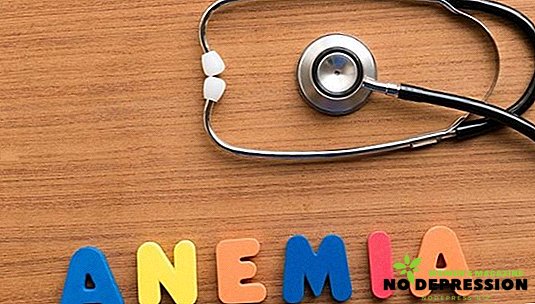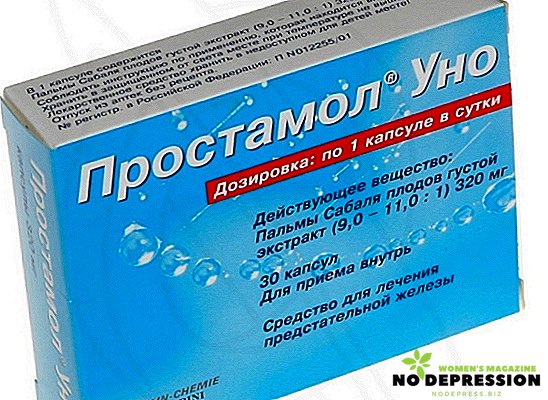Anemia - a decrease in the level of hemoglobin in the blood is less than the acceptable value. In most cases, a decrease in the level of erythrocyte cells is observed in the complex. This is not a separate disease, but a symptom of primary pathology.

What is anemia?
 With anemia, the concentration of hemoglobin and erythrocytes in the blood decreases. The latter provide gas exchange in the human body, the supply of oxygen and carbon dioxide to the internal organs, deliver nutrients and metabolic products to the tissues and cells for further processing.
With anemia, the concentration of hemoglobin and erythrocytes in the blood decreases. The latter provide gas exchange in the human body, the supply of oxygen and carbon dioxide to the internal organs, deliver nutrients and metabolic products to the tissues and cells for further processing.
Erythrocyte cells are composed of hemoglobin - a protein that gives the blood a rich red color. Hemoglobin includes iron, which, if insufficient in the body, provokes the onset of iron deficiency anemia.
3 factors are involved in the development of this pathological condition:
- hemorrhage - acute or chronic;
- hemolysis is the breakdown or destruction of red blood cells;
- reduced production of red blood cells by the red bone marrow.
In addition, there are other factors predisposing to the development of pathology, which are quite numerous.
Leading to iron deficiency
In most cases, iron deficiency anemia is diagnosed in women, especially during pregnancy, in adolescents aged 12-17 years. In men, this condition is more common in old age. In children, anemia is detected if the woman’s pregnancy was multiple.
The reasons contributing to the development of pathology include:
- unhealthy diet;
- pathology of the gastrointestinal tract;
- a history of bleeding;
- increased body's need for iron.
It is the latter reason that causes the occurrence of pathology in childhood and during pregnancy.

People at risk are more likely to have this condition:
- newborns;
- children in active growth;
- pregnant women and breastfeeding women;
- women in reproductive age.
During pregnancy, a woman is obliged to replenish double the volume of iron, because half of it must be ingested by the fetus. By the time of delivery, about 300 mg of this substance is collected in the baby’s body, which is obtained from the mother.
For infants, the only source of iron intake is breast milk. If it is not enough, the woman will also suffer a child. The trace element contributes to the formation of nervous tissue, so its insufficient content adversely affects the development of the newborn.
Symptoms of anemia and how dangerous it is
Clinical manifestations largely depend on the severity of anemia:
- 1 degree: hemoglobin level - 90-110 g / l;
- 2 degree: hemoglobin level - 70-90 g / l;
- 3 degree: hemoglobin level is less than 70 g / l.
 Symptoms of anemia are divided into 2 groups: anemic and sideropenic.
Symptoms of anemia are divided into 2 groups: anemic and sideropenic.
In the first case, a person's pulse quickens, there is a feeling of lack of air, general malaise, dizziness, rapid loss of strength, headache. The efficiency is lost, it is difficult for a person to concentrate on routine matters, he becomes irritable. In some cases, there is muscle aches and tinnitus.
Anemic symptoms are not considered specific for this pathology and may be inherent in another disease. Such manifestations as blanching of the skin, mucous membranes, lowering of blood pressure are alarming.
Sideropenic symptoms occur on the background of a decrease in the volume of substances other than hemoglobin, which include iron in their composition. For such a syndrome is characterized by a change in the condition of the skin: it becomes dry, peels off. Nails begin to exfoliate, fragility increases. Among sideropenic symptoms - the appearance of cracks in the corners of the mouth, on the tongue, reduction of smell.
The condition is dangerous because with an untimely start of therapy an anemic coma may occur, a violation of the activities of other organs and systems, especially those in which comorbidities occur.
Types of anemia
Symptoms largely depend on the type of pathology. In medicine, there is its division into 5 types, which have their causes.
Aplastic anemia
 Aplastic anemia - a condition that is expressed in anemia, a sharp decrease in immunity, impaired blood clotting. Often occurs due to heredity, on the background of diseases such as Shvahman-Diamond syndrome, erythrocyte aplasia, dyskeratosis.
Aplastic anemia - a condition that is expressed in anemia, a sharp decrease in immunity, impaired blood clotting. Often occurs due to heredity, on the background of diseases such as Shvahman-Diamond syndrome, erythrocyte aplasia, dyskeratosis.
The acquired form is due to direct toxic effects on hematopoietic cells: ionizing radiation, pesticides, heavy metal salts, benzene and its derivatives. The occurrence of pathology is also influenced by certain drugs, for example, anticancer, nonsteroid, Levomycetin and Analgin.
There is a theory according to which a condition arises against the background of a viral infection: hepatitis, paravirus, cytomegalovirus, Epstein-Barr virus. These cause a failure in the protective function of the body, which causes the attack of its own tissues.
Hypochromic anemia
Hypochromic anemia is a pathology characterized by a change in the color of the blood. Norm - 0.85-1.1. With the development of anemia, the indicator drops to 0.85 or less.
Among the common causes - insufficient content in the body of iron - a substance that is part of hemoglobin. Excessive loss thereof is observed in blood loss in the acute or chronic course. Development is affected by poor nutrition, for example, the inclusion in the diet of only plant products.
Hemolytic anemia
 Hemolytic anemia is a condition characterized by accelerated destruction of red blood cells with the release of an increased amount of indirect bilirubin. In most cases, hereditary causes, such as the presence of erythropoietic porphyria, affect the development of anemia. Other factors: incompatible blood transfusion, history of vaccination, infectious diseases.
Hemolytic anemia is a condition characterized by accelerated destruction of red blood cells with the release of an increased amount of indirect bilirubin. In most cases, hereditary causes, such as the presence of erythropoietic porphyria, affect the development of anemia. Other factors: incompatible blood transfusion, history of vaccination, infectious diseases.
In addition, the development is influenced by mechanical factors - the presence of an artificial heart valve, etc. For other reasons include burns, spider bites, some snakes.
Megaloblastic anemia
Megaloblastic anemia is a condition caused by insufficient levels of vitamin B12 and folic acid in the body. Substances like iron synthesize erythrocyte cells.
The cause of the pathology is malnutrition with restriction of the use of products containing these trace elements in the composition. Some pathologies of the gastrointestinal tract, medication, for example, anti-metabolic or anticonvulsant, are also considered as sources of development.
Pernicious anemia
Pernicious anemia - a condition that occurs against the background of insufficient content in the body of vitamin B12. Among the reasons - the deterioration of the absorption of the element and folic acid in the gastrointestinal tract, which has a congenital or acquired etiology.
During pregnancy and lactation, pernicious anemia develops against the background of concomitant psoriasis, exfoliative dermatitis.
Diagnosis and treatment of anemia
First of all, they carry out activities to determine the type of anemia, as well as the reasons conducive to its appearance. When making a diagnosis, the doctor takes into account the fact that hemoglobin levels depend on the person’s age and gender.
The basis for the diagnosis are laboratory tests:
- a blood test taken from a finger, which allows to determine the hemoglobin content in the blood;
- biochemical examination of blood taken from a vein, which allows to determine the volume of iron and the bilirubin fraction;
- diagnostics of the state of the digestive tract organs (rectoromanoscopy, fibrogastroscopy, irrigoscopy, etc.).

It also requires a visit to a hematologist - a doctor who specializes in the pathologies of the circulatory system.
After the diagnosis, an appropriate therapy is started, the features of which depend on the type of pathology. In any case, therapeutic activities are carried out in stationary conditions. The treatment is based on the intake of vitamin B12 and iron preparations. In some cases, blood transfusions are performed.
The patient must adhere to proper nutrition during the period of therapy with the inclusion in the diet of a sufficient amount of protein, iron, vitamins. If post-hemorrhagic anemia is observed, stop bleeding is required.
In the treatment of aplastic anemia, blood transfusion is used, bone marrow transplantation, treatment with glucocorticoids and anabolic agents are prescribed.
Anemia in women during pregnancy
In pregnant women, iron deficiency can be caused by the following reasons:
- unhealthy diet;
- concomitant diseases that occur with a lack of protein involved in iron metabolism;
- early and late preeclampsia;
- frequent childbirth with a small interval;
- multiple pregnancy;
- chronic pathologies of the digestive tract.

If you do not eliminate this condition, you can cause complications, including:
- preterm delivery;
- preeclampsia;
- lower blood pressure;
- placental abruption before labor;
- fetal growth retardation;
- anemia in a child.
Considering such dangerous consequences, you shouldn’t allow anemia to take its course during pregnancy, but you should adhere to the recommendations and prescriptions of the doctor for its treatment.
Disease prevention
The first preventative rule is to maintain a balanced diet with adequate intake of foods rich in iron, ascorbic acid, vitamin B12, and folic acid. Those at risk are recommended to undergo regular medical examinations.
If you find signs of anemia, do not self-medicate. Otherwise, you can not only slow recovery, but also cause additional harm to health.












